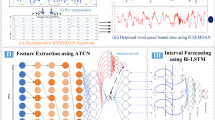Abstract
Accurate wind speed prediction is essential for optimal operation and planning. The unstable and stochastic nature of the wind makes the task complicated and challenging. As a result, a hybrid approach is implemented to enhance prediction accuracy and to overcome the difficulties and challenges in uncertainty modelling. Encoder and decoder are the two parts of the proposed hybrid model. In this study, a one-dimensional convolutional neural network (1D-CNN) is used as the encoder, and a bidirectional long short term memory network (Bi-LSTM) is used as the decoder. Encoder extracts the important characteristics and forms a latent representation. Then, wind speed is predicted by the decoder network by interpreting the characteristics of the encoded representation. The hybrid approach is validated using several regular and widely used benchmark forecasting models to assess and examine its prediction performance. The prediction results using the real-time dataset obtained from a wind measuring station in Idalia, Colorado are used for performance evaluation. The performance validation analysis showed that the proposed hybrid approach has an improvement of 42% over the reference approaches.









Similar content being viewed by others
References
Dantzig GB, Wolfe P (1960) Decomposition principle for linear programs. Op Res 8(1):101
Xu J, Xie B, Liao S, Yuan Z, Ke D, Sun Y, Li X, Peng X (2021) Load shedding and restoration for intentional Island with renewable distributed generation. J Mod Power Syst Clean Energy 9(3):612
Sumathi S, Kumar LA, Surekha P (2015) in Solar PV and wind energy conversion systems (Springer), pp. 247–307
Council GWE (2020) Global wind report 2019 released on April
Teeparthi K, Kumar DV (2018) Security-constrained optimal power flow with wind and thermal power generators using fuzzy adaptive artificial physics optimization algorithm, Neural Computing and Applications. Neural Comput Appl 29(3):855
Ganesh J (2002) Principles of forecasting: a handbook for researchers and practitioners
Afshari-Igder M, Niknam T, Khooban MH (2018) Probabilistic wind power forecasting using a novel hybrid intelligent method. Neural Comput Appl 30(2):473
Jayasingh SK, Mantri JK, Pradhan S (2020) Intelligent systems: proceedings of ICMIB 2020 P.35
Zhang Y, Zhao Y, Kong C, Chen B (2020) A new prediction method based on VMD-PRBF-ARMA-E model considering wind speed characteristic. Energy Conversion Manag 203
Chaudhuri S, Dutta D (2014) Mann-Kendall trend of pollutants, temperature and humidity over an urban station of India with forecast verification using different ARIMA models. Environ Monitor Assess 186(8):4719
Kim Y, Hur J (2020) An ensemble forecasting model of wind power outputs based on improved statistical approaches. Energies 13(5):1071
Cadenas E, Rivera W, Campos-Amezcua R, Cadenas R (2016) Wind speed forecasting using the NARX model, case: La Mata, Oaxaca, México. Neural Comput Appl 27(8):2417
Hervás-Martínez C, Salcedo-Sanz S, Gutiérrez PA, Ortiz-García EG, Prieto L (2012) Evolutionary product unit neural networks for short-term wind speed forecasting in wind farms. Neural Comput Appl 21(5):993
Yadav G.R, Muneender E, Santhosh M(2021) in 2021 International conference on sustainable energy and future electric transportation (SEFET) (IEEE), pp. 1–6
Ko MS, Lee K, Kim JK, Hong CW, Dong ZY, Hur K (2020) Deep concatenated residual network with bidirectional LSTM for one-hour-ahead wind power forecasting. IEEE Trans Sustain Energy 12(2):1321
Santhosh M, Venkaiah C, Kumar DV (2019) Short-term wind speed forecasting approach using ensemble empirical mode decomposition and deep Boltzmann machine. Sustain Energy, Grids Netw 19:100242
Hernández-Travieso JG, Travieso-González CM, Alonso-Hernández JB, Canino-Rodríguez JM, Ravelo-García AG (2019) Modeling a robust wind-speed forecasting to apply to wind-energy production. Neural Comput Appl 31(11):7891
Wang SX, Li M, Zhao L, Jin C (2019) Short-term wind power prediction based on improved small-world neural network. Neural Comput Appl 31(7):3173
Shahid F, Zameer A, Iqbal MJ (2021) Intelligent forecast engine for short-term wind speed prediction based on stacked long short-term memory. Neural Comput Appl pp. 1–17
Ruiz-Aguilar JJ, Turias I, González-Enrique J, Urda D, Elizondo D (2021) A permutation entropy-based EMD-ANN forecasting ensemble approach for wind speed prediction. Neural Comput Appl 33(7):2369
Khelil K, Berrezzek F, Bouadjila T (2021) GA-based design of optimal discrete wavelet filters for efficient wind speed forecasting. Neural Comput Appl 33(9):4373
Li S, Goel L, Wang P (2016) An ensemble approach for short-term load forecasting by extreme learning machine. Appl Energy 170:22
Zhang CY, Chen CP, Gan M, Chen L (2015) Predictive deep Boltzmann machine for multiperiod wind speed forecasting. IEEE Trans Sustain Energy 6(4):1416
Jiang P, Li R, Zhang K (2018) Two combined forecasting models based on singular spectrum analysis and intelligent optimized algorithm for short-term wind speed. Neural Comput Appl 30(1):1
Ulkat D, Günay ME (2018) Prediction of mean monthly wind speed and optimization of wind power by artificial neural networks using geographical and atmospheric variables: case of Aegean Region of Turkey. Neural Comput Appl 30(10):3037
Kiranyaz S, Avci O, Abdeljaber O, Ince T, Gabbouj M, Inman DJ (2021) 1D convolutional neural networks and applications: A survey. Mech Syst Signal Process 151:107398
Wang P, Qian Y, Soong F.K, He L, Zhao H(2015)A unified tagging solution: bidirectional lstm recurrent neural network with word embedding. arXiv preprint arXiv:1511.00215
Author information
Authors and Affiliations
Corresponding author
Ethics declarations
Conflict of interest
The authors declare that they have no conflict of interest.
Additional information
Publisher's Note
Springer Nature remains neutral with regard to jurisdictional claims in published maps and institutional affiliations.
Rights and permissions
About this article
Cite this article
Kosana, V., Teeparthi, K. & Madasthu, S. Hybrid convolutional Bi-LSTM autoencoder framework for short-term wind speed prediction. Neural Comput & Applic 34, 12653–12662 (2022). https://doi.org/10.1007/s00521-022-07125-4
Received:
Accepted:
Published:
Issue Date:
DOI: https://doi.org/10.1007/s00521-022-07125-4




